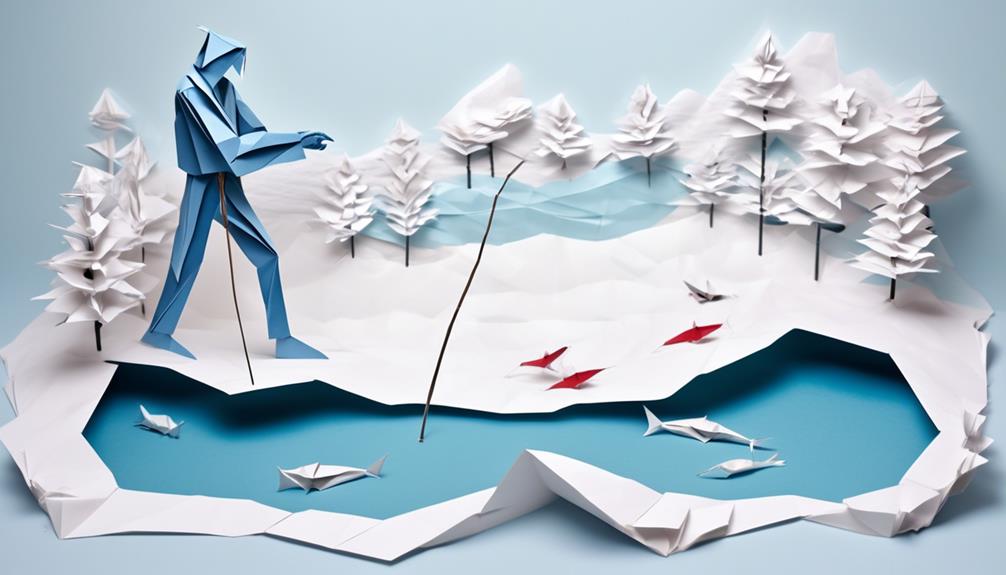There’s a theory among ice anglers that deadstick fishing is a passive game, a waiting strategy with less skill than jigging. I’ve spent countless hours on the frozen lakes, rod in hand, questioning that assumption.
It’s a method that’s often misunderstood, even by seasoned fishers. Deadsticking isn’t just about planting your rod and hoping for a bite; it’s about understanding the subtle interplay between stillness and the inevitable draw of live bait. It’s a test of patience, sure, but there’s an art to it that goes unnoticed by many.
As we explore the nuances of deadstick ice fishing—from the gear that’ll serve you best to the perfect bait presentation and location selection—I’ll share insights that have turned my once skeptical view into a profound respect for this technique.
And I’m confident that by the end of our journey, you’ll see deadsticking in a new light, as a skillful dance with the quiet under-ice world that’s just waiting to be mastered.
Key Takeaways
- Deadstick ice fishing requires precise rigging and patience
- Choosing the right location with structure and depth is crucial
- Live bait and presentation are essential for success
- Being adaptable and making tactical adjustments can maximize catch rate
Understanding Deadstick Techniques

Deadstick ice fishing, a technique that hinges on the subtle art of inactivity, requires precise rigging and patience to effectively lure and catch fish beneath the ice. I’ve spent countless hours on frozen lakes, mastering the craft of letting my bait do the work while I keep still. It’s not about flashy movements or constant jigging; it’s about presenting that bait in the most natural, irresistible way possible.
To nail this technique, I rig my line with a live minnow or a soft plastic that mimics the subtle movements of prey. I drop it down the hole, set my rod in a holder, and wait. The trick is in the balance – the bait must move enough to entice, but not so much it spooks the fish. I watch my rod tip like a hawk, ready to spring into action the moment it twitches. It’s a passive approach, but when that line goes tight, the rush is anything but passive.
For those yearning for freedom from the constant hustle, deadstick ice fishing offers a serene escape. You’re not just catching fish; you’re embracing the quiet, honing your senses, and finding liberation in the stillness of ice-covered waters.
Essential Gear for Deadsticking
While mastering the patient art of deadstick ice fishing, I’ve come to rely on a few key pieces of gear that make all the difference when out on the ice.
First off, a sensitive rod is crucial – it’s your direct line to what’s happening below. I prefer a medium-light rod with just enough backbone to set the hook firmly.
Next, can’t stress enough the importance of a reliable reel with a smooth drag system. You’re looking for something that’ll let you play the fish without any jerks or hiccups.
I’m all about the quality line as well. Fluorocarbon is my go-to since it’s nearly invisible underwater and has minimal stretch for a solid hookset.
Then there’s the bait. Live bait’s fantastic, but on days when it’s quiet, an attractant can be a game-changer. I use one that mimics the scent of natural prey, and it often turns lookers into biters.
Lastly, I always have a portable sonar. It’s like having X-ray vision through the ice, showing me exactly where to place my bait.
Every piece of gear I choose is about giving me the freedom to focus on the fish, not fussing with my equipment. It’s these essentials that turn waiting into catching.
Choosing the Right Location

Selecting the ideal spot is as critical as the gear you carry, since fish tend to congregate in specific areas beneath the ice. Experience has taught me that you can’t just drill a hole anywhere and expect the fish to come calling. Instead, you’ve got to think like a fish. Here’s what I look for:
- Structure and Depth
- Drop-offs and ledges
- Underwater humps
- Weedy flats and basins
Fish are creatures of habit, sticking to underwater highways just like we stick to roads. They love edges and transitions, places where shallow waters dip into the deep, or where the bottom topography changes dramatically. I’m always scanning for those key underwater structures using a combination of maps and electronics.
- Water Clarity and Light
- Murky waters near inlets
- Clear areas with ample sunlight
Visibility plays a huge role in how fish behave under the ice. In stained waters, they’re less spooky, while in gin-clear lakes, the midday brightness can send them scurrying.
- Forage and Food Sources
- Presence of baitfish
- Insect hatches
Wherever there’s a food party, the predators are bound to show up. I drill my holes over active feeding areas, listening for the dinner bell that tells me I’m in the right spot.
Bait Selection and Presentation
Having pinpointed the prime fishing spot, I now focus on choosing the right bait and mastering its presentation to outsmart the fish below the ice. It’s all about reading the environment and the fish’s mood. I lean towards live bait – wax worms, minnows, or maggots – because they bring that irresistible wiggle that drives fish wild. But I’ll let you in on a secret: it’s not just what you use, it’s how you use it.
Presentation is king in deadstick ice fishing. I carefully thread my bait to keep it lively and tempting, adjusting the size to match the fish I’m after. If they’re finicky, I downsize – smaller hook, smaller bait – to coax that bite. I position my bait right where I know the fish patrol, just off the bottom or amongst cover, where they feel safe enough to strike.
I’m always watching for the subtlest nibble, ready to spring into action. There’s an art to setting the hook just right – too hard and you’ll lose them, too soft and they won’t commit. It’s a delicate dance between patience and precision, and I revel in the challenge.
This, my friends, is the path to ice fishing liberation.
Maximizing Your Catch Rate

To maximize my catch rate, I constantly adjust my tactics in response to the ever-changing conditions beneath the ice. It’s not just about dropping a line and hoping for the best; it’s about being strategic and responsive. Here’s how I stay ahead:
- Understanding Ice Conditions
- Thinner ice near inlets/outlets can mean more oxygen and active fish.
- Mid-winter clarity calls for lighter lines and subtler presentations.
- Late-season melt can stir things up, making fish less predictable.
- Tactical Adjustments
- Switching lure sizes or colors if bites slow down.
- Altering the depth of my bait to find the active feeding zone.
- Using sound-emitting lures to attract curious fish in a quiet environment.
- Staying Mobile
- Drilling multiple holes to cover different depths and structures.
- Moving every 30 minutes if the action isn’t heating up.
- Keeping a close eye on the fish finder for signs of life.
I’ve learned that freedom on the ice means breaking from tradition and being willing to adapt. I’m not chained to one spot or one technique. If I’m not catching, I’m moving, changing, and doing whatever it takes to find those fish. It’s about liberation from old habits and the thrill of the chase under the frozen surface.

